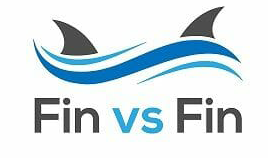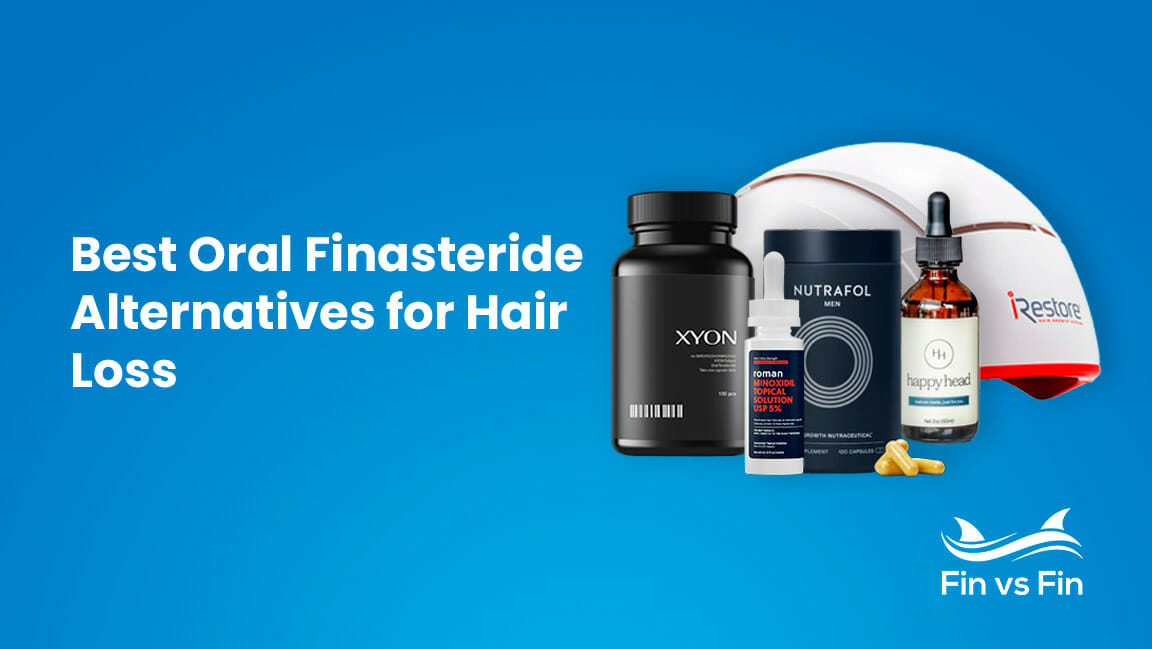Oral finasteride, known commonly under the brand name Propecia, is an FDA-approved treatment used for certain hair loss conditions, however, it may not work for everyone. Oral finasteride alternatives for hair loss include:
- Dutasteride
- Topical finasteride
- Minoxidil (Rogaine)
- Laser caps (LLLT)
- Hair loss supplements, such as biotin and saw palmetto
Oral finasteride alternatives are increasing in popularity as more research emerges for these hair loss treatment options. For example, research suggests that dutasteride may be more effective than finasteride when it comes to treating male pattern hair loss, despite not being FDA-approved for this condition. Other finasteride substitutes, such as saw palmetto and biotin, have also shown promising results when it comes to hair loss treatment.
In this article, we explore the pros and cons of various prescription, OTC, and natural finasteride alternatives for hair loss. In addition, we discuss their potential benefits and side effects.
Best Alternatives to Oral Finasteride
Best Overall: Topical Finasteride
| Stronger Rx Alternative: Dutasteride
| Most Affordable: Minoxidil
| Least Invasive: Laser Caps
| All-Natural: Biotin and OTC Supplements
|
|---|---|---|---|---|
| Topical finasteride works effectively for most men, and is associated with fewer side effects than when taken orally. Thus, it’s most popular for those looking for a safer alternative. | Research indicates that dutasteride is even more effective than oral finasteride for increasing hair count, albeit with a similar risk of unwanted sexual health-related side effects. | Minoxidil, also known as Rogaine, is an FDA-approved treatment for certain hair loss conditions and it tends to cost less than oral finasteride pills. | Laser caps are non-invasive and effective, emitting light of a specific wavelength to boost blood and oxygen flow required for growth. | Biotin and other over-the-counter supplements contain ingredients that may address nutritional deficiencies related to hair health. |
1. Dutasteride: A Stronger Finasteride Alternative
Dutasteride and finasteride both prevent testosterone conversion to dihydrotestosterone (DHT), a hormone that can have a significant impact on the hair loss cycle and hair thinning. They do so by inhibiting an enzyme called 5-alpha reductase, which comes in two types of isoenzymes known as type 1 and type 2.
Finasteride inhibits type 2, whereas dutasteride inhibits type 1 and type 2, preventing more testosterone from being converted to DHT. Blocking DHT is associated with boosting hair growth and preventing further hair loss.
Dutasteride Pros + Cons
Pros
- May be more effective than finasteride for some individuals
- Can be compounded with other active ingredients to help support healthy hair growth
- Available in four different forms including capsules, tablets, gel, and solution
Cons
- Not FDA-approved to treat hair loss conditions
- Cannot be purchased OTC and requires a prescription
- Side effects are comparable to finasteride and tend to occur at similar rates
Dutasteride Benefits
Research notes that dutasteride may be up to three times more effective than finasteride in treating male pattern baldness, specifically when it comes to increasing total hair count. Studies also suggest that dutasteride may be used to treat female pattern hair loss in certain individuals.
In addition, it may be used to prevent further hair loss and promote hair regrowth in individuals with frontal fibrosing alopecia, a somewhat rare condition that causes progressive, permanent hair loss, typically impacting individuals over the age of 50.
Side Effects
Dutasteride is generally well tolerated, however, some individuals may experience side effects, including:
- Decreased sex drive
- Ejaculation issues
- Difficulty having or maintaining an erection
Seek emergency care if you have:
- Difficulty breathing
- Difficulty swallowing
- Breast pain or tenderness
- Face swelling
- Severe skin concerns, such as peeling
Compare Popular Dutasteride Products
Where to Get Dutasteride Online | |||
|---|---|---|---|
| Monthly Price | $129 per month for topical $387 for a 3-month supply | $39 per month for oral $69 per month for topical | $59 per month for oral $44 for the first month, then $89 thereafter for topical |
| Application Method | Topical gel | Oral capsules or topical solution | Oral capsules + topical solution |
| Quantity in 3mo supply | Depends on your prescription | 90 oral capsules 3 x 30mL bottles of topical solution | 90 oral capsules 3 x 60mL bottles of topical solution |
| Contains other active ingredients? | ❌ | ✅ Minoxidil, tretinoin, fluocinolone, or biotin Topical solution is custom compounded. | ✅ SuperCapsules combine dutasteride, minoxidil, and vitamin D Topical solution combines dutasteride and minoxidil |
| Recommended Use | Once per day | Once per day | Once per day |
| Website |
3. Topical Finasteride: Is it better than oral?
Topical finasteride is a prescription medication that is applied directly to the scalp. Like finasteride that is taken orally, it aims to reduce DHT, which contributes to hair thinning and hair loss in certain individuals.
Topical finasteride formulations act directly on the hair follicles without first going through the digestive system and liver, which may help decrease side effects.
Topical Finasteride Pros + Cons
Pros
- Can be compounded with other ingredients, such as minoxidil
- May lead to fewer side effects than oral medications
- Easy to apply and comes in gel, solution, foam, and cream
- Has a similar level of effectiveness as oral finasteride for some individuals
Cons
- May cause scalp irritation and other skin issues
- Requires a prescription and cannot be purchased OTC
- Not FDA-approved to treat hair loss conditions
Benefits of Topical Finasteride
Research suggests that topical finasteride significantly improves hair count in individuals who are experiencing symptoms associated with a hair loss condition.
Other studies comparing the use of topical finasteride twice a day versus taking oral finasteride once a day found a similar level of effectiveness for both groups. In addition, combining topical finasteride with topical minoxidil is associated with an even higher level of treatment effectiveness, in some individuals.
Side Effects
Because it is not taken orally, it may lead to less side effects compared to its pill counterpart. If side effects are experienced, they tend to mainly impact the scalp.
Side effects of topical finasteride may include:
- Itchy scalp
- Patchy, red, or irritated skin on the scalp
- Itchy rash on the scalp
- Burning feeling on the scalp
Compare Topical Finasteride Products
Where to Get Topical Finasteride Online | ||||||
|---|---|---|---|---|---|---|
| Monthly Price | $40 per month | $35-$50 per month | $79 per month | $99 per month | $59 per month | $50/month (billed $150 quarterly) |
| Application Method | Gel | Spray | Dropper | Cream | Gel or solution | Spray |
| Quantity in 3mo supply | 30mL | 60mL | 60mL | 90mL | 90mL | 🟡 3 month's supply |
| Active Ingredients | .25% finasteride 5% minoxidil | .3% finasteride 6% minoxidil | .3% finasteride 8% minoxidil 0.001% retinoic acid 1% hydrocortisone | <2.5% finasteride | <.25% finasteride <7.5% minoxidil <.0125% tretinoin <.01% fluocinolone | .3% finasteride 6% minoxidil 0.025% tretinoin |
| Recommended Use | Once daily | Once daily | Twice daily | Once daily | Once daily | Once daily |
| Website | ||||||
3. Minoxidil: Budget-Friendly Finasteride Alternative (and Compliment)
Minoxidil is an FDA-approved OTC topical solution that is applied directly to the scalp. Products that contain minoxidil, like Rogaine, work by increasing blood flow to the hair follicles.
Increased blood flow can help stimulate hair growth and slow down hair loss. It also lengthens the anagen phase, or hair growth phase, and simultaneously shortens the telogen phase, or rest phase in which hair shedding occurs.
Minoxidil Pros + Cons
Pros
- FDA-approved hair regrowth treatment for adults
- Available to purchase OTC in pharmacies and online
- Associated with fewer side effects than oral hair loss medications
Cons
- Temporary solution as hair loss begins when you stop treatment
- Can take 3-6 months to see results
Benefits of Minoxidil
Topical minoxidil is FDA-approved to treat male and female pattern hair loss, however, research notes that it may also be effective in treating other conditions, such as:
- Alopecia areata, an autoimmune condition that leads to hair loss
- Chemotherapy-related hair loss
- Telogen effluvium, a reversible hair loss condition caused by various stressors
- Eyebrow and/or beard hair loss
While not FDA-approved, oral minoxidil is also associated with increased hair thickness and hair growth in individuals with various hair loss conditions.
In general, studies suggest that it is considered safe and effective when it comes to boosting hair growth and slowing down hair loss for numerous conditions.
Side Effects
Side effects associated with topical minoxidil tend to impact the scalp and may include:
- Scalp itching or burning
- Scalp dryness or flaking
- Scalp irritation
Seek urgent medical care if you experience:
- Fast heartbeat
- Chest pain
- Trouble breathing
- Feeling lightheaded
- Swelling
Compare Top Minoxidil Brands
Where to get Minoxidil Online | ||||
|---|---|---|---|---|
| Monthly Price | $11.11 per month for foam $7.33 per month for solution | $15 per month | $23 for first month (use code GOHAIR) $59 per month after the first month | $30 per month for the oral pill $16 per month for solution |
| Application Method | Topical solution or foam | Topical solution | Topical solution | Oral pill or topical solution |
| Quantity in 3mo supply | 180mL | 180mL | 180mL | 90 oral pills 60mL for the solution |
| Contains other active ingredients? | ❌ | ❌ | ✅ .01% retinoic acid 1% hydrocortisone | ❌ |
| Recommended Use | Twice per day | Twice per day | Once per day in the first week, twice per day afterward | 1 tablet per day Apply solution twice per day |
| Website |
4. Laser Caps: A Non-Pharma Finasteride Alternative
Laser caps for hair loss use low-level laser therapy (LLLT), which is also called red light therapy, to stimulate hair growth.
The cap contains several lasers that emit light at a specific wavelength and energy level. This light penetrates the scalp and hair follicles, which increases blood flow, oxygenation, and energy production to promote hair growth and slow down hair loss.
Laser Caps Pros + Cons
Pros
- FDA-approved treatment for male and female pattern hair loss
- Non-invasive and painless
- Device is generally considered safe and can be used at home
- Cost-effective in long-run
- Requires less frequent use and is easy to use
Cons
- High initial price with some products ranging from about $700 to over $1,000
- May be time consuming as some individuals may need to use it every other day for 30 minutes
- Needs more research on overall safety and effectiveness especially when it comes to long-term use
Benefits of Laser Caps
In general, laser caps may be effective in promoting hair growth, extending the growth phase of the hair cycle, as well as shortening the telogen, or hair shedding, phase, however, more research is still needed.
Research that compared the effectiveness of LLLT used every other day to topical minoxidil, which was applied twice a day, found that individuals who used the laser cap had slightly better hair growth outcomes.
In addition, studies also note that, when compared to sham treatments, laser caps were quite effective in increasing hair density, as well as overall thickness in both assigned females and assigned males.
Side Effects
Individuals who have used laser caps tend to report either no side effects or minor side effects that typically resolve in about two weeks without additional treatment.
However, side effects are still possible and may include:
- Dry skin and irritation on the scalp
- Scalp tenderness
- A warm feeling on the scalp
- Itchy scalp
Compare Top LLLT Caps for Hair Loss
What's the Best LLLT Laser Cap for You? | Theradome | Capillus | ||
|---|---|---|---|---|
| Price | $695-$1,195 | $995 | $880-$3,000 | $749-$1,049 |
| Number of Diodes | 120-282 | 80 | 128-304 | 148-272 |
| Wavelength | 650nm (red light) | 680nm | 650nm | 650nm |
| Scalp Coverage | Top + Back + Side | Top + Back | Top + Back | Top + Back |
| Weight | 2-3lbs | 1.5lbs | 4lbs | 1 pound |
| How to charge | Portable rechargable battery | Cordless rechargable battery | Portable rechargable battery | Portable rechargable battery |
| Recommended Use | 25-minute sessions every other day | 20 minutes 2x per week | 6 minutes per day | 30 minutes every other day |
| Website |
5. OTC Hair Loss Supplements: Best Natural Finasteride Alternative
Over-the-counter (OTC) substitutes for finasteride may include biotin, saw palmetto, as well as other vitamins, minerals, and herbal supplements, like green tea extract. These products typically contain ingredients that are believed to promote hair growth or improve the health of the hair and scalp.
In general, these ingredients work in different ways to support hair health and potentially promote hair growth.
Biotin and OTC Supplements Pros + Cons
Pros
- May address nutritional deficiencies that contribute to hair loss
- Available in flavorful gummies, in some cases
- May not be associated with as many side effects compared to prescription medications
Cons
- Limited effectiveness compared to prescription options
- Lack of research supporting appropriate use for hair loss treatment
Benefits OTC Hair Loss Supplements
Biotin, a B vitamin, plays a role in the production of keratin, a protein that is essential for strong and healthy hair. Research suggests that individuals with poor hair growth experienced an improvement in hair growth after taking a biotin supplement in as little as 10 days, with some experiencing total symptom resolution within eight months. However, more research is still needed.
Vitamins, like B vitamins and vitamin D, as well as minerals, such as iron, may help provide the hair follicles with the nutrients they need to produce healthy hair. For certain hair loss conditions, like male or female pattern baldness, research notes that addressing nutritional deficiencies may help improve symptoms.
Green tea extract may help stimulate hair growth by triggering a mechanism that encourages the hair to go from the resting phase to the growth phase. In addition, it may also stimulate blood flow to the scalp and increase hair density.
Saw palmetto, a botanical extract, can be used topically or taken orally. Similarly to finasteride and dutasteride, it works by blocking the conversion of testosterone to DHT. Some studies suggest that saw palmetto may help improve hair density, hair count, and hair quality in individuals with various hair loss conditions.
Side Effects
Side effects for OTC and natural finasteride alternatives can vary, but may include:
- Nausea and vomiting
- Organ damage
- Allergic reaction
- Increased risk of bleeding
Always speak to your healthcare provider before taking an OTC supplement, herbal remedy, or vitamin to ensure it is safe for you to do so. Keep in mind that some OTC or natural products can negatively interact with a current medication you are taking.
Compare OTC and Natural Finasteride Alternatives
Best All-Natural Alternatives To Finasteride | |||
|---|---|---|---|
| Price per Month | $19.75 | $16 | $22 |
| Quantity per Bottle | 120 capsules | 30 gummies | 120 capsules |
| Key Ingredients | Biotin Vitamins A, C, D, & E Iodine Zinc Selenium | Biotin | Biotin Vitamins A & D Collagen Keratin Saw palmetto Probiotics Ashwagandha |
| Recommended Daily Intake | 4x | 1x | 4x |
| Website |
The Verdict: What's the Best Substitute for Finasteride?
If you’re worried about the potential side effects of oral finasteride or you’re unable to take it, there are plenty of alternatives to choose from, including dutasteride, topical finasteride, minoxidil, laser caps, as well as natural and OTC options.
Be sure to speak with your healthcare provider before selecting a product for your unique hair loss concerns to ensure it is safe for you to use. Remember that finasteride alternatives will work differently for each individual and it may take some time before you find one that is best suited to your needs.
Frequently Asked Questions (FAQ)
Is saw palmetto better than finasteride?
In general, finasteride works better than saw palmetto. However, in individuals who are unable to use finasteride due to side effects, saw palmetto may be an option to try.
Keep in mind that, unlike finasteride, saw palmetto is not FDA-approved to treat hair loss conditions and there is limited research on how effective it actually is. Always speak with your healthcare provider before trying any new supplement.
Is finasteride heavy on the liver?
Research suggests that long-term use of finasteride is associated with non-alcoholic fatty liver disease, a condition where fat builds up in the liver.
Is oral finasteride the only way to stop hair loss?
No, there are other options available, including dutasteride, minoxidil, laser caps, topical finasteride, as well as various supplements that may be effective for some individuals.
Oral medications are associated with increased systemic absorption compared to topical options, which can lead to a higher risk of unwanted side effects. In other cases, oral finasteride just may not work well for your specific needs and trying a finasteride alternative may be the next appropriate step.
Always speak with your healthcare provider before starting a new medication regimen, even if you’re using an OTC option.
Methodology
We conduct extensive research to evaluate the pricing, effectiveness, accessibility, overall quality, and user experience of every telehealth service we review. This also includes examining and comparing each provider to comparable telemedicine alternatives. We also evaluate usability, treatments, prescription delivery time, and more to determine the best value for those seeking fast and reliable telehealth services.
| Review Process | Key Metrics | Weighting |
|---|---|---|
| Sign up online | – ease to complete intake form – affordability – upfront commitment or subscription required? – money back guarantee or refund policy? | 0.5 |
| Vitual consult with provider / determine eligibility | – ease to get appointment to determine eligibility – need to leave house for labs or other in-person care? | 1 |
| Shipping + unboxing | – shipping cost – time from order to treatment delivery – discreet packaging to maintain privacy | 0.5 |
| Test + journal for 1-3 months | – ease of application – transition into habitual use – taste / smell / feel / pain | 1.5 |
| Results after 3 months of use | – efficacy / results – lack of side effects – ease of refill / reordering – quality of ongoing clinical support – responsive customer support – willingness to recommend to a friend | 1.5 |
Browse More Hair Loss Reviews
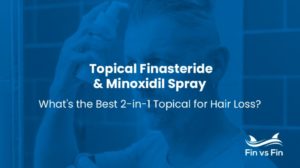
Topical Finasteride and Minoxidil Spray Review – What’s the Best 2-in-1 Topical for Hair Loss?
If you’ve been looking into treatment for pattern hair loss (androgenic alopecia), you may have come across the ingredients minoxidil and finasteride, which are the two most popular and clinically-backed treatments for thinning hair that come in both oral and topical form. Brands like Hims,

Tretinoin and Hair Loss: Does It Help Regrow Hair?
Key Takeaways Topical tretinoin may support hair growth by increasing circulation to the scalp and boosting cell turnover. Up-to-date clinical research indicates that tretinoin can enhance the effects of minoxidil for hair growth. The most common side effects of tretinoin are skin irritation, dryness, and
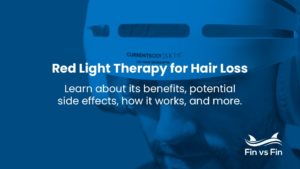
Red Light Therapy for Hair Loss: Does It Promote ReGrowth?
Key Takeaways Red light therapy can safely and effectively treat hair loss in some individuals. It typically takes four to six months to see results from red light therapy. Red light therapy can promote regrowth and hair retention. While many types of red light therapy

How to Get Oral Minoxidil Online: A Complete Guide
Key Takeaways Oral minoxidil is a good option for individuals with androgenic alopecia who experience side effects from topical minoxidil or who are not seeing the results they hoped for. You can get an oral minoxidil prescription online by completing a virtual consultation with a

Does High Blood Pressure Cause Hair Loss?
Key Takeaways While some studies do show a potential association between high blood pressure and hair loss, more research is still needed. High blood pressure can affect blood flow, potentially impacting blood flow to the scalp and hair follicles. Some medications used to treat high
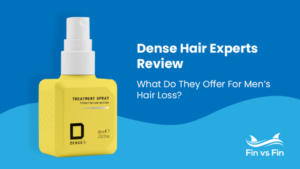
Dense Hair Experts Review: What Do They Offer for Men’s Hair Loss?
Dense Hair Experts Overview Price: £59.99 (or £47.99 on subscription) Prescription products: Finasteride, dutasteride OTC products: Minoxidil, shampoo, conditioner, vitamins, styling products Active ingredients: Finasteride, dutasteride, minoxidil Potential side effects: Itching, redness, flaking Who it’s best for: Individuals experiencing male pattern baldness Go to Site→
